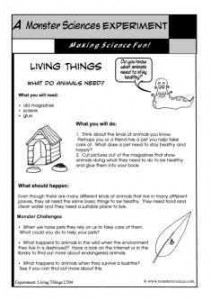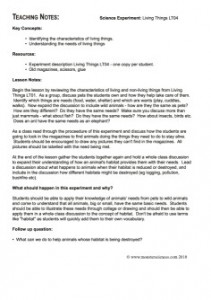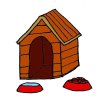Investigate what animals need to live and thrive, not just pets but other living things in our environment too.
 |
 |
Monster Sciences Living Things Experiment: What do animals need?
What you will need:
• old magazines
• scissors
• glue
What you will do:
Think about the kinds of animals you know. Perhaps you or a friend has a pet you help take care of. What does a pet need to stay healthy and happy?
Cut pictures out of the magazines that show animals doing what they need to do to be healthy and glue them into your book. What should happen: Even though there are many different kinds of animals that live in many different places, they all need the same basic things to be healthy. They need food and clean water and they need a suitable place to live.
Monster Challenges:
• When we have pets they rely on us to take care of them. What could you do to help your pets?
• What happens to animals in the wild when the environment they live in is destroyed? Have a look on the internet or in the library to find out more about endangered animals.
• What happens to animals when they survive a bushfire? See if you can find out more about this.
Teaching Notes: Monster Sciences Experiment: Living Things LT04
Key Concepts:
• Identifying the characteristics of living things.
• Understanding the needs of living things Resources:
• Experiment description Living Things LT04 – one copy per student.
• Old magazines, scissors, glue
Lesson Notes:
Begin the lesson by reviewing the characteristics of living and non-living things from Living Things LT01. As a group, discuss pets the students own and how they help take care of them. Identify which things are needs (food, water, shelter) and which are wants (play, cuddles, walks). Now expand the discussion to include wild animals – how are they the same as pets? How are they different? Do they have the same needs? Make sure you discuss more than just mammals – what about fish? Do they have the same needs? How about insects, birds etc. Does an ant have the same needs as an elephant?
As a class read through the proceedure of this experiment and discuss how the students are going to look in the magazines to find animals doing the things they need to do to stay alive. Students should be encouraged to draw any pictures they can’t find in the magazines. All pictures should be labelled with the need being met.
At the end of the lesson gather the students together again and hold a whole class discussion to expand their understanding of how an animal’s habitat provides them with their needs. Lead a discussion about what happens to animals when their habitat is reduced or destroyed, and include in the discussion how different habitats might be destroyed (eg logging, pollution, bushfire etc).
What should happen in this experiment and why?
Students should be able to apply their knowledge of animals’ needs from pets to wild animals and come to understand that all animals, big or small, have the same basic needs. Students should be able to illustrate these needs through collage or drawing and should then be able to apply them in a whole class discussion to the concept of habitat. Don’t be afraid to use terms like “habitat” as students will quickly add them to their own vocabulary.
Follow up question:
• What can we do to help animals whose habitat is being destroyed?



